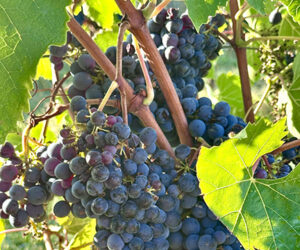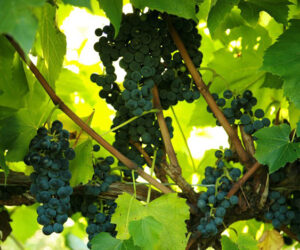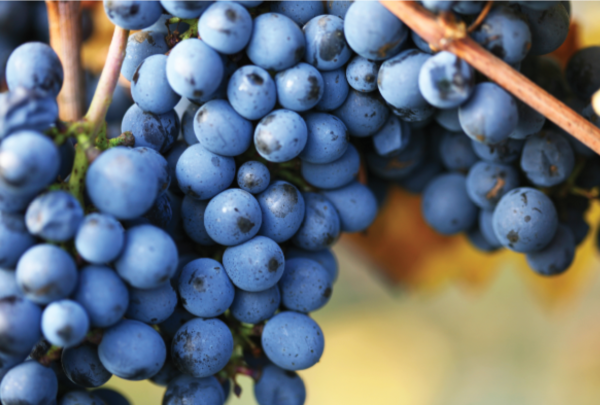 Pinot Noir suffers no fools. Grow it in the wrong soil or in a slightly inappropriate climate and the wine will be about as pleasant as a princess who’s slept on a rocky mattress. Imagine the planet Earth spinning, and as the continents roll by you place a colorful marker on the spots amenable to growing world-class Pinot. There are barely a dozen spots to mark: Many in California (Central Coast, North Coast, Monterey County), the Willamette Valley of Oregon, New Zealand (include, if you must, parts of Australia and Tazmania), and of course in Europe including isolated exposures in Germany, Alsace, Austria, Switzerland, and France (Champagne, Burgundy). Other locales may emerge, but for now Pinot Noir production is extremely limited by proper geography/geology. A perfect storm of climate and rarified dirt is required to make a palatable Pinot; to make a profound bottle takes a miracle.
Pinot Noir suffers no fools. Grow it in the wrong soil or in a slightly inappropriate climate and the wine will be about as pleasant as a princess who’s slept on a rocky mattress. Imagine the planet Earth spinning, and as the continents roll by you place a colorful marker on the spots amenable to growing world-class Pinot. There are barely a dozen spots to mark: Many in California (Central Coast, North Coast, Monterey County), the Willamette Valley of Oregon, New Zealand (include, if you must, parts of Australia and Tazmania), and of course in Europe including isolated exposures in Germany, Alsace, Austria, Switzerland, and France (Champagne, Burgundy). Other locales may emerge, but for now Pinot Noir production is extremely limited by proper geography/geology. A perfect storm of climate and rarified dirt is required to make a palatable Pinot; to make a profound bottle takes a miracle.
Duke Philip the Bold of France, in the Burgundian Edict of 1395, declared all non-Pinot Noir vines that produced red wine in Burgundy to be ripped out under the threat of arrest, and possibly execution. Good Phil was saying, “We’re not drinking any Gamay.” Phillip was my hero for years, and I steeped myself in Burgundian wine mythology, committing to memory each village that lay between Marsannay and Santenay. Burgundy was the Holy Land, and when I learned the proper incantations (‘Oh, Montrachet, Mother of Vines . . .’) I was fortunate enough to make my first pilgrimage in 1999. And like any proper religious journey, the truth I found was nearly opposite of what I expected. I chased the white stag into the forests above Nuits-St.-Georges, but the treasure I found there turned to dust as I boarded the 767 for Los Angeles, about the same time I was served an awful piece of airplane beef.
Core Pinot Noir
Knowing how to grow and make good Pinot Noir in Burgundy won’t do you much good in the United States or elsewhere in the New World. The Pinot Noir vine is so sensitive and site-specific that it speaks its own language in every climate where it can be coaxed from the soil. California’s Anderson Valley has different challenges than the Santa Maria Valley; Burgundy and Germany make wildly different wines, and the challenges of growing and making the wine are just as maddening.
So why do we bother? A great Pinot Noir is the pinnacle of the wine firmament. There is no other wine as challenging to grow and vinify, and when you get a great one life changes — the clouds part to let the sun shine upon your face, you may end up in amazement that nature (guided by man) can provide such a vehicle for carrying the flavors of a time and place. We strive to make Pinot Noir for the same reason that we master chess, base jump off of Half Dome, or try to climb Everest. It is a risk; it’s the hardest alcohol on the planet to get right, and if your equipment and game isn’t perfect, you can feel as though you’ve been dashed on the boulders below.
In the New World, the greatest Pinots come from coastally influenced areas with a special combination of soil, altitude, aspect, and climate. Why does it matter to the average wine drinker that a Pinot Noir be grown in a cool, coastal climate? First: Pinot Noir is expensive by nature. Because the vines produce small clusters, small berries, and small yields, it’s expensive to farm. If you plan to drop $50 on a bottle of Pinot Noir, be sure it was grown in a place that produces consistently delicious Pinot. Second, there is a natural limit on how much good Pinot Noir can be produced in a vintage worldwide. Scarcity drives the price tag up.
The film “Sideways,” released in 2004, didn’t help the scarcity problem. That clever little movie about men behaving badly under Pinot’s Bacchic influence did for the Pinot grape what the Soviet Union did to socialism. And even though neither of the movie’s pathetic characters got their come-uppance, the poetic descriptions of Pinot drove the US wine market into a temporary frenzy for
the grape. Demand soared and prices went up.
Finally, the Pinot grape is unlike any other in the sense that it is perfectly transparent: It shows everything that was done to it in the vineyard, it shows (unmercifully at times) the vintage’s weather. Some may even say Pinot Noir is a time machine; pay special attention to what you smell and taste in the glass and a fine Pinot will take you somewhere, even back to the year when it was grown. In a cool year you may taste (imagine cool, Pacific breezes and foggy mornings) some bracing acidity and bright cherry, raspberry with hints of baking spices. In a warmer, riper year (imagine sunny mornings, warm afternoons and cold, starry nights) the wine may have blueberry, strawberry, blackberry and more masculine, even gamey aromas. But try to grow the grape in an inappropriate climate and it will show, dramatically, every mistake in the vineyard and the winery. Be prepared, Pinot Noir is not a beginner’s wine.
Roundtable Discussion
For this story, I rounded up some of my favorite Pinot Noir winemakers in California to answer some questions about growing and making Pinot Noir. As I did in my “Rosé Roundtable” in the April-May 2015 issue of WineMaker, I will answer the questions myself as well.

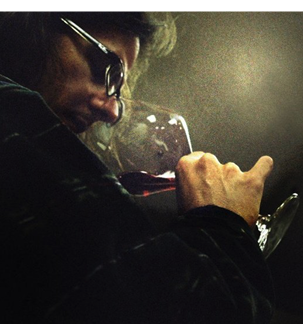
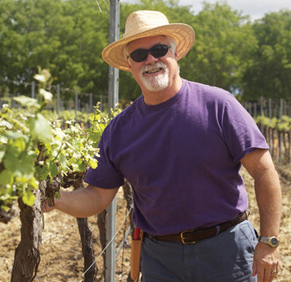
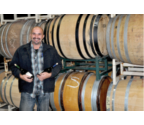
What was the first Pinot Noir you tasted that changed your perspective of what the varietal could do in the glass? (Seminal wine experience)
Wes Hagen: I remember the exact moment when I was initiated into the higher wisdom of all things Burgundian. It was January 11, 1999 and I was visiting Burgundy for the first time.
There are not many wines that you can isolate in your memory and say, “THAT bottle made me decide to dedicate my life to Pinot Noir.” Maybe you remember with similar clarity the first wine that struck your head and your olfactory sensibilities with an undeniable, complex profundity. I will admit sincerely that when I swirled that (slightly brickish) garnet-colored potion (a.k.a. 1972 L. Trapet Chappelle-Chambertin) and deeply whiffed its bouquet, I suddenly realized that there was some deep truth in the hyperbole and hoopla surrounding the Cult of Pinot Noir — and more specifically, the Cult of the Perfect Bourgogne.
Here are the tasting notes I made that night at the Chateau de Gilly: “Harmonious nose suggesting the deeper secrets of Burgundian terroir – opened up with both the sternness of solid acid and the muscle of seriously intense fruit and perfect cellaring. In the mouth: Plum and dry spice, understated game and leather – this wine, if needed to be categorized, was light of color and mostly feminine in taste profile — light extraction, super-fine sediment that tasted of smoke. Spicy roundness that builds with bottle-aged fruit flavors, violet and rose petal in the nose and mouth, building into a massive feminine beast still hinting of vanilla, oak and herb. After tasting the wine with us, our host at the Rotisserie de Chambertin said two things: (On opening the bottle): ‘This wine waited for tonight to be perfect.’ (on finishing the bottle): ‘The last drink is like saying goodbye to an old friend.’ The man spoke with a nearly religious intensity and regaled us for an hour with stories and anecdotes about the region of Chambertin.”
David Vergari: A 1972 Armand Rous-seau Red Burgundy I tasted when I interned at James Halliday’s Coldstream Hills winery in Australia’s Yarra Valley. The year was 1992. It was a magnum from James’s incredible cellar. The wine was astonishing. I was absolutely gobsmacked by its fruit, acidity, and seamlessness. A twenty-year-old Pinot Noir??? This was the seminal moment when I realized the possibilities that Pinot Noir possessed. I was hooked, man.
Aaron Mercer: There have been many — and although not my first — but tasting the 2002 Domaine de la Romanee-Conti (DRC) La Tache while leaning on a basket press after a 12-hour winery shift is the one that stands out. Pure brilliance.
Vidal Perez: It was different lots of wild/resident yeast fermented 2009 Bien Nacido Vineyard Pinot Noir that we had crushed in open top fermenters for one of our custom crush customers. The variety of flavors and aromas the different lots produced in combination with the wild yeast made me realize how much I loved Pinot Noir.
Does Pinot Noir deserve its reputation as the world’s hardest wine to craft? Why or why not?
Wes Hagen: Yes and no. When Pinot Noir is harvested from the right vineyard at the right moment, it’s an easy wine to make. The pH is low and the acid tends to be high, so it has an innate stability that really keeps the wine balanced and healthy through fermentation and aging. But Pinot Noir requires the perfect environment, soil, and climate to thrive. Grow it someplace it doesn’t belong, like a backyard in Long Beach, California, and it will show you how it responds. I made that wine (from a backyard in Long Beach, California) and it smelled like dill pickles floating on an oil spill.
David Vergari: I don’t give this much thought. In my opinion, it’s a matter of finding the right place to source outstanding fruit, and then working conscientiously with the vines throughout the growing season, doing the work when it’s time to do the work and spending the time in the vineyard. Ulysses Van der Kamp (of Sonoma’s Van der Kamp Vineyard) says, “It’s easy to grow good Pinot Noir if you’re willing to be in the vineyard eleven hours a day.”
Aaron Mercer: Yes and no. I don’t believe Pinot should be ‘crafted’ but rather be ‘nurtured’ from quality grapes that express place, soil and sun. The ‘crafting’ then comes from the site selection, trellising, pruning, and the numerous other cultural practices employed at the vineyard. Hence much of the direction of the wine is done prior to me — as a winemaker — getting involved.
Vidal Perez: Yes I think so, for several reasons. The first one being it is very sensitive to weather, it makes better wine in cool regions and it is very prone to bunch rot. It is also a very low yield producer and it could be very light in color if you don’t do your homework as a winemaker.
If you had to choose three pieces of advice for small production or home winemakers making Pinot Noir for the first time, what would they be?
Wes Hagen: First, Pinot Noir requires commitment, not flirtation. If you are going to jump into the deep end, commit. I suggest buying at least 1,000 lbs. (454 kg) of fruit and making an entire barrel of wine. Carboys and small fermentations can go wrong in many ways that a larger, semi-commercial sized lot will not. 1,000 lbs. (454 kg) should get you a 55-gallon (208 L) barrel full of wine and a few carboys for topping. Keep the carboys filled with wine for topping up heavily sulfited (undrinkably sulfited) to keep them from oxidizing, and they will also add small amounts of SO2 each time you top the barrels. Top up your barrels every two weeks religiously.
Second, cold soak and press the wine at dryness. Chill the freshly picked/delivered fruit down to 50 °F (10 °C) or cooler (or have it picked at night and delivered in a chilled truck), and crush/destem it cold.
Third, I would not do stem inclusion or new oak for my first three to five years of making Pinot Noir (or any wine) until you get a true and accurate idea of your craft and the flavors they create. Once you can make great and tasty Pinot Noir from stainless or neutral oak vessels, then you can start applying oak and other affectation.
David Vergari: One: Inspect what you expect. That is, visit the vineyard regularly to ensure the grower is fulfilling their obligations and backing up what they say. I’ve worked with my fair share of jerks who talk out of both sides of their mouths; if you encounter one, kick the SOB to the curb, it’s simply not worth it and the resulting wine will not fulfill its promise. If your gut says the grower is trying to get one over on you, run — don’t walk — away. Two: Get the best grapes that you can afford. Be stupid, spend the money. Three: Do NOT overoak the wine! This practice drives me up the wall. It’s such a waste of good fruit.
Aaron Mercer: There are three DON’Ts of Pinot Noir: 1) Don’t overthink it. They are grapes. They will become wine whether you get involved or not. 2) Don’t overwork the grapes. Do you really want a Pinot that tastes like Cabernet? It is a delicate varietal and should be treated as such. 3) Don’t over-oak it. Although this is pretty ambiguous and depends entirely on the individual and the grapes (see “don’t” #2). It’s delicate.
Vidal Perez: Start with the best grapes you can get, adjust the pH for optimal fermentation conditions, and punch down/pump over at least twice a day for optimal color extraction.
Would you be willing to share a simplified “recipe” for making great Pinot Noir? Vineyard source, Brix/pH targets, flavors, yeast, add-ins, cold soak, stems, pressing, aging, racking, sulfiting could all be touched on, but keep it as simple and short as you have time for.
Wes Hagen: I like Pinot Noir fruit from California for deliciousness and consistency: Santa Maria Valley, the Santa Rita Hills AVA, Russian River, Sonoma Coast, or Anderson Valley. Home winemakers will likely be able to source purchased fruit from these areas nationwide. Shoot for 24-25 °Brix if you do not want to water/acidulate, and 26-28 °Brix if you want to make a bigger wine (water/acidulate back to 24 °Brix and 3.4 pH pre-ferment). I prefer Assmanhausen yeast or RC-212. Cold soak at 40–50 °F (4–10 °C) until the must warms and shows signs of ferment (bubbles on sides), and then pitch your yeast into a corner after rehydrating/attenuating. I press at dryness, 0 °Brix or less on a hydrometer, and never rack off the lees unless the wine gets stinky. Age in French oak (neutral Troncais is my fave) for 11–36 months. Age less for a fresher, age-able wine, longer for a wine more ready-to-drink and mellow. After malolactic fermentation completes, get the wine to 0.8 molecular free SO2 and keep it there until bottling.
David Vergari: I don’t use a recipe; it’s obvious that my chief priority is obtaining grapes from the “right” location. This is usually the warmest part of a cool winegrowing area.
Aaron Mercer: I really don’t believe in recipes for making wine as I would encourage experimentation which will produce the flavors you like. Although Mama’s tomato sauce recipe has been passed through the generations, the location, type, picking date (etc.) are very different from those of the inaugural recipe. You should experiment. If forced to give ‘guidelines’ I would say the following:
• Location: Pick somewhere close to you so you can get a feel for the grapes throughout the growing season.
• Brix/pH/Flavors: These should all be looked at as a whole. Within reason the Brix and pH can be adjusted, but the flavor cannot. You may have the perfect Brix/pH relationship (say 23-24/3.40-3.50) but no flavor. Inversely a wine with abundant flavor picked at 21 °Brix may seem pretty thin. This is a definite balancing act.
• Yeast/Add-ins: I am an advocate for adding yeast and adjusting the acidity where necessary. This is the ‘safest’ approach, and I believe the best way to show the true characters of the grape and make the most consistent wine year-to-year. This may seem contradictory to my ‘nurture’ comment earlier, however I feel making a technically sound and consistent wine for the consumer my primary role. Indigenous yeasts and no additions could act as a part of the ‘recipe’ but require an experienced practitioner.
• Cold Soak/Stems: I would certainly employ cold soak (one to three days) on Pinot Noir as I like to extract the delicate tannins without the presence of alcohol that come with post-fermentation maceration. Although I like the inclusion of stems, they must be ripe and you must be experienced. If you choose to include them remember: A little goes a long way.
• Pressing/Aging/Racking: Press when dry. I don’t feel that Pinot Noir benefits from hanging out on skins like some other varietals. Age in barrel (a mix of new and old) for nine to 12 months racking as necessary. Pinot is pretty fragile so excessive racking can be detrimental.
•SO2/Filtration: I would use SO2 at many stages throughout the process — pre-fermentation on the fruit, post malolactic fermentation, during aging and pre-bottle. I would also filter regardless. I have never seen detrimental effects from filtration and it gives me peace of mind to sleep at night.
Vidal Perez:
• Vineyard source: Cool climate, under 80 °F (27 °C) highs with cooling at night.
• Brix/pH targets: 24.5 °Brix, 3.55 pH.
• Flavors: ripe.
• Yeast: Wild in combination with inoculated to finish.
• Add-ins: Tartaric acid if needed.
• Cold soak: Two days.
• Stems: No stems, they make a veggie/green wine.
•Pressing: At dryness.
• Aging: 30% French oak for a year, racking after malolactic fermentation.
• SO2: Immediately after malolactic fermentation completion to prevent undesirable microbe growth like Bretttanomyces. More could all be touched on, but keep the process as simple and as short as you have time for.
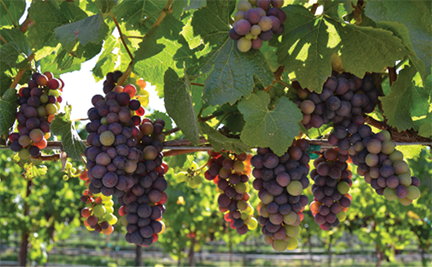
What’s one secret of Pinot Noir that no one seems to know or talk about?
Wes Hagen: It’s a really easy wine to make if you source great fruit and pay attention to topping and SO2.
David Vergari: How the young wine changes/evolves in the first several months of its life. It’s simply all over the place. This is NOT the time to do anything more than keep a sharp eye on the volatile acidity (VA) and maintain a regular topping schedule, particularly if the wine is not finished with its ferments. Do not keep counsel of your fears. There’s no need to act rashly in the majority of instances. This is just Ms. Pinot messing with your head.
Aaron Mercer: Not a secret necessarily, but people rarely look to Pinot Noir when stocking their cellars with “age-worthy” wines. Pinot Noir is generally grown in cooler climates and as such generally have lower pH which is critical for cellaring for any extended periods. There are many examples (although mainly from Burgundy) of Pinot Noir that has been aged from 20, 50, or even a 100 years and is still in excellent drinking condition.
Vidal Perez: Pinot Noir goes well with a lot more food than you can think of.
Conclusion
Pinot Noir is certainly not a beginner’s wine. It’s called the “Heartbreak Grape” for a reason. But don’t get discouraged, as all of these professional Pinot-wranglers all agree on one piece of advice: Find really good, balanced Pinot Noir fruit and making the wine is not all that difficult. I really do love this grape (and what it can do in the glass) more than any other red varietal, so give it a chance if you are brave. Let me know how it goes: [email protected].



